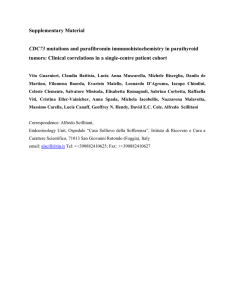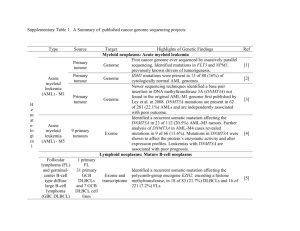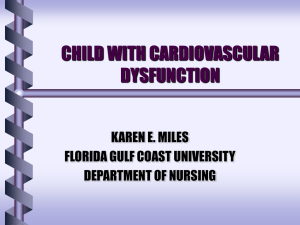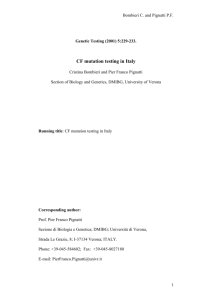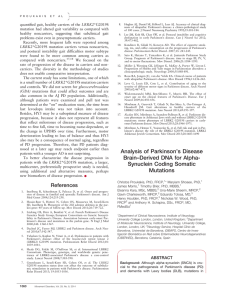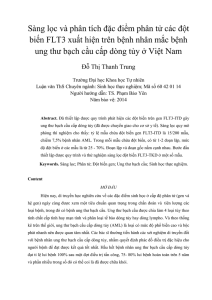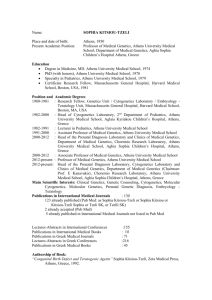Journal: Human Genetics - Springer Static Content Server
advertisement
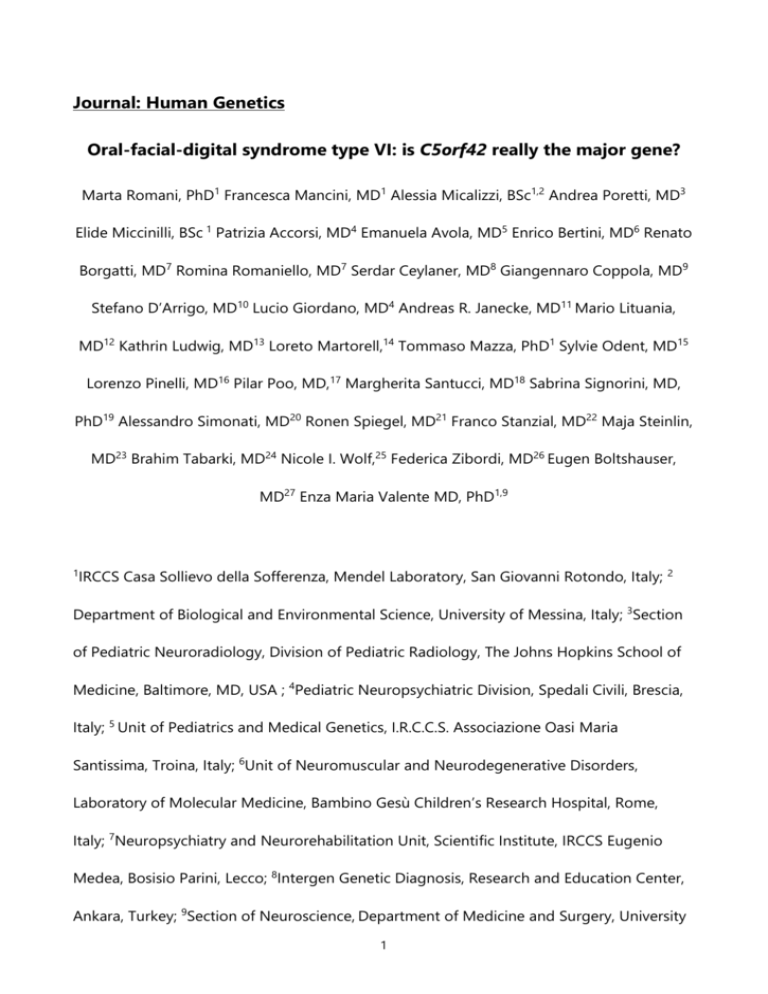
Journal: Human Genetics Oral-facial-digital syndrome type VI: is C5orf42 really the major gene? Marta Romani, PhD1 Francesca Mancini, MD1 Alessia Micalizzi, BSc1,2 Andrea Poretti, MD3 Elide Miccinilli, BSc 1 Patrizia Accorsi, MD4 Emanuela Avola, MD5 Enrico Bertini, MD6 Renato Borgatti, MD7 Romina Romaniello, MD7 Serdar Ceylaner, MD8 Giangennaro Coppola, MD9 Stefano D’Arrigo, MD10 Lucio Giordano, MD4 Andreas R. Janecke, MD11 Mario Lituania, MD12 Kathrin Ludwig, MD13 Loreto Martorell,14 Tommaso Mazza, PhD1 Sylvie Odent, MD15 Lorenzo Pinelli, MD16 Pilar Poo, MD,17 Margherita Santucci, MD18 Sabrina Signorini, MD, PhD19 Alessandro Simonati, MD20 Ronen Spiegel, MD21 Franco Stanzial, MD22 Maja Steinlin, MD23 Brahim Tabarki, MD24 Nicole I. Wolf,25 Federica Zibordi, MD26 Eugen Boltshauser, MD27 Enza Maria Valente MD, PhD1,9 1 IRCCS Casa Sollievo della Sofferenza, Mendel Laboratory, San Giovanni Rotondo, Italy; 2 Department of Biological and Environmental Science, University of Messina, Italy; 3Section of Pediatric Neuroradiology, Division of Pediatric Radiology, The Johns Hopkins School of Medicine, Baltimore, MD, USA ; 4Pediatric Neuropsychiatric Division, Spedali Civili, Brescia, Italy; 5 Unit of Pediatrics and Medical Genetics, I.R.C.C.S. Associazione Oasi Maria Santissima, Troina, Italy; 6Unit of Neuromuscular and Neurodegenerative Disorders, Laboratory of Molecular Medicine, Bambino Gesù Children’s Research Hospital, Rome, Italy; 7Neuropsychiatry and Neurorehabilitation Unit, Scientific Institute, IRCCS Eugenio Medea, Bosisio Parini, Lecco; 8Intergen Genetic Diagnosis, Research and Education Center, Ankara, Turkey; 9Section of Neuroscience, Department of Medicine and Surgery, University 1 of Salerno, Salerno, Italy; 10Developmental Neurology Division, Fondazione IRCCS Istituto Neurologico C. Besta, Milano, Italy; 11Department of Pediatrics I and Division of Human Genetics, Innsbruck Medical University, Innsbruck, Austria; 12Preconceptional and Prenatal Physiopathology, Galliera Hospital; 13Surgical Pathology and Cytopathology Unit, Department of Medicine (DIMED), University of Padova, Padova, Italy; 14Department of Molecular Genetics, Hospital Sant Joan de Déu, Barcelona, Spain ; 15Service de Génétique Médicale, CHU Hôpital Sud, Rennes, France; 16Department of Neuroradiology, Spedali Civili, Brescia, Italy; 17Department of Neurology, Hospital Sant Joan de Déu, Barcelona, Spain ; 18Pediatric Neuropsychiatry Unit, IRCCS Istituto di Scienze Neurologiche, Bologna, Italy; 19Centre of Child Neuro-ophthalmology, Unit of Child Neurology and Psychiatry, C. Mondino National Neurological Institute, Pavia; 20Department of Neurological Sciences and Movement-Neurology (Child Neurology), University of Verona, Verona, Italy; 21Genetic Institute, Emek Medical Center, Afula, Israel; 22Department of Pediatrics, Genetic Counselling Service, Regional Hospital of Bolzano, Bolzano, Italy; 23 Department of Pediatric Neurology, University Children’s Hospital, Berne, Switzerland ; 24Division of Pediatric Neurology, Prince Sultan Military Medical City, Riyadh, Saudi Arabia; 25Department of Child Neurology, VU University Medical Center and Neuroscience Campus Amsterdam, Amsterdam, The Netherlands; 26Department of Child Neurology, Fondazione IRCCS Istituto Neurologico “Carlo Besta,” Milan, Italy; 27Department of Pediatric Neurology, University Children’s Hospital, Zurich, Switzerland. Corresponding author: Prof. Enza Maria Valente, MD, PhD 2 Neurogenetics Unit CSS-Mendel Institute Viale Regina Margherita 261 00198 Rome, Italy Ph: +39 06 4416 0537 Fax: +39 06 4416 0548 Email: e.valente@css-mendel.it 3 Supplementary material Methods Patients’ cohort included a total of 313 probands representative of the whole clinical spectrum of JS, recruited by the unique neuroimaging criterion of the molar tooth sign (MTS). Among them, 17 living patients matched the diagnostic criteria for OFDVI (Poretti et al. 2012). For each patient, a standardized clinical questionnaire filled by the referring clinician allowed to obtain detailed information on the phenotypic spectrum and the extent of organ involvement. Written informed consent was obtained from all families, and the study was approved by the local ethics committee. All patients underwent simultaneous target sequencing of 50 ciliopathy genes (see Supplementary Table 2), including the C5orf42 gene and other 21 genes causative of Joubert syndrome), on a Solid 5500xL platform (Life Technologies). Sensitivity of the technique was assessed by sequencing 54 patients already known to carry point mutations or very small insertions/deletions in several JS causative genes: each previously identified mutation (either in the compound heterozygous or homozygous state) could be confirmed by target sequencing on the Solid platform, demonstrating a very high sensitivity of the adopted protocol. To amplify C5orf42, probes have been designed to cover each of the 52 exons of the longest isoform of the gene (NM_023073, encoding a 3197 amino acid protein), with splice-site junctions and at least 30 bp of flanking introns. Due to the very high coverage obtained (mean depth 400X), we could verify that each base pair of the C5orf42 coding sequence was covered at least 20X in every patient. Nevertheless, it must be said that next 4 generation sequencing techniques might fail to detect certain types of mutations (such as larger insertions or deletions), and therefore we cannot be sure that our C5orf42 mutation frequency could be slightly underestimated. All identified mutations in C5orf42 were validated using bidirectional Sanger sequencing. Confirmed mutations were searched against public databases dbSNP ver.141 (http://www.ncbi.nlm.nih.gov/SNP/) and Exome Variant Server (http://evs.gs.washington.edu/EVS/), and their potential pathogenicity was predicted using prediction software PolyPhen-2 ver.2.2.2 (http://genetics.bwh.harvard.edu/pph2/) and SIFT (http://sift.jcvi.org/). Nomenclature was assigned according to the Human Genome Variant Society (http://www.hgvs.org/mutnomen/). Characterization of C5orf42 mutations In this work, we identified 37 distinct mutations in the C5orf42 gene (of which 30 novel), including 19 missense, 10 nonsense, 6 frameshift and 2 splice-site mutations (Figure 1). Thirty-three mutations were not found in public databases dbSNP ver.141 and Exome Variant Server, while four were present in dbSNP/EVS with extremely low (0.0077 to 0.021%) or no reported minor allele frequency, and never in the homozygous state. All novel missense mutations were predicted as damaging or not tolerated by both prediction web tools. 5 Clinical features of C5orf42 mutated OFDVI probands Patient 1 Patient NG3674 is a 4 years-old boy born from non-consanguineous parents, compound heterozygous for C5orf42 missense mutation c.C3599T; p.A1200V and nonsense mutation c.T7817A; p.L2606X. Fetal ultrasound at 26 gestational weeks showed an enlarged fourth ventricle. His neonatal period was characterized by breathing abnormalities, hypotonia and nystagmus. Clinical examination showed mild intellectual impairment and mesoaxial polydactyly of hands and preaxial polydactyly of feet, in the absence of any clear oral features. Visual evoked potentials were reduced bilaterally. A brain MRI showed the MTS. Patient 2 Patient NG1610, a 12 years-old boy born from unrelated parents, was compound heterozygous for the two C5orf42 missense mutations c.G3551A; p.R1184H and c.A4034G; p.Q1345R. Pregnancy and delivery were unremarkable. He had a complex phenotype characterized by severe developmental delay, ataxia, ocular motor apraxia, preaxial polydactyly of hands and feet, tongue hamartomas and multiple lingual frenula. He was diagnosed with Hirschsprung disease, while renal, hepatic and retinal functions were normal. Brain MRI at age 2 years showed the MTS associated with hypothalamic hamartoma, thin corpus callosum and bilateral polymicrogyria. This patient had been previously reported in Poretti et al. 2012 (patient 11). 6 Supplementary References Alazami AM, Alshammari MJ, Salih MA, Alzahrani F, Hijazi H, Seidahmed MZ, Abu Safieh L, Aldosary M, Khan AO, Alkuraya FS (2012) Molecular characterization of Joubert syndrome in Saudi Arabia. Hum Mutat 33: 1423-1428. doi: 10.1002/humu.22134 Ohba C, Osaka H, Iai M, Yamashita S, Suzuki Y, Aida N, Shimozawa N, Takamura A, Doi H, Tomita-Katsumoto A, Nishiyama K, Tsurusaki Y, Nakashima M, Miyake N, Eto Y, Tanaka F, Matsumoto N, Saitsu H (2013) Diagnostic utility of whole exome sequencing in patients showing cerebellar and/or vermis atrophy in childhood. Neurogenetics 14: 225-232. doi: 10.1007/s10048-013-0375-8 Poretti A, Brehmer U, Scheer I, Bernet V, Boltshauser E (2008) Prenatal and neonatal MR imaging findings in oral-facial-digital syndrome type VI. AJNR Am J Neuroradiol 29: 10901091. doi: 10.3174/ajnr.A1038 Romani M, Micalizzi A, Valente EM (2013) Joubert syndrome: congenital cerebellar ataxia with the molar tooth. Lancet Neurol 12: 894-905. doi: 10.1016/S1474-4422(13)70136-4 Shaheen R, Faqeih E, Alshammari MJ, Swaid A, Al-Gazali L, Mardawi E, Ansari S, Sogaty S, Seidahmed MZ, Almotairi MI, Farra C, Kurdi W, Al-Rasheed S, Alkuraya FS (2013) Genomic analysis of Meckel-Gruber syndrome in Arabs reveals marked genetic heterogeneity and novel candidate genes. Eur J Hum Genet 21: 762-768. doi: 10.1038/ejhg.2012.254 Srour M, Hamdan FF, Schwartzentruber JA, Patry L, Ospina LH, Shevell MI, Desilets V, Dobrzeniecka S, Mathonnet G, Lemyre E, Massicotte C, Labuda D, Amrom D, Andermann E, 7 Sebire G, Maranda B, Rouleau GA, Majewski J, Michaud JL (2012a) Mutations in TMEM231 cause Joubert syndrome in French Canadians. J Med Genet 49: 636-641. doi: 10.1136/jmedgenet-2012-101132 Srour M, Schwartzentruber J, Hamdan FF, Ospina LH, Patry L, Labuda D, Massicotte C, Dobrzeniecka S, Capo-Chichi JM, Papillon-Cavanagh S, Samuels ME, Boycott KM, Shevell MI, Laframboise R, Desilets V, Maranda B, Rouleau GA, Majewski J, Michaud JL (2012b) Mutations in C5ORF42 cause Joubert syndrome in the French Canadian population. Am J Hum Genet 90: 693-700. doi: 10.1016/j.ajhg.2012.02.011 8 Supplementary Table 1 – Prevalence of clinical features in C5orf42 mutated patients reported to date Nr. of patients (including fetuses with confirmed diagnosis) Clinical phenotype: - pure JS - JS with retina - JS with kidney - cerebello-oculo-renal - JS with liver - OFDVI - MKS-like fetuses Specific clinical features: - neurological signs (living pts) - retinopathy (living pts) - kidney/liver involvement - any oral-facial feature - tongue hamartomas / multiple lingual frenulaa - other oral-facial featuresb - any polydactyly - mesoaxial polydactylya - preaxial polydactyly - postaxial polydactyly - any CNS abnormality besides MTS - hypothalamic hamartomaa - occipital meningoencephalocele - other CNS abnormalitiesc - other congenital abnormalities outside the CNSd Srour 2012b Srour 2012a Alazami 2012 Ohba 2013 Lopez Shaheen 2013 Present study TOTAL (%) 10 1 3 2 12 1 29 58 10 - 1 - 2 1 - 2 - 12 (8 fetuses) - 1 26* (1 fetus) 1 2 - 41 (70.7%) 2 (3.4%) 14 (24.1%) 1 (1.7%) 10 - 1 - 3 1 - 2 - 4 6 1 28 1 1* 2 48/48 (100%) 2/48 (4.2%) 1/58 (1.7%) 9/56 (16.1%) - - - - 5 - 1 6 (10.7%) 1 1 1 - - 1 1 - - 4 12 6 12 9 9 5 4 1 1 1 - 1 15 1 13 6 4 1 2 2 6 (10.7%) 28/58 (48.3%) 7 (12.1%) 26 (44.8%) 16 (27.6%) 15/58 (25.9%) 6 (10.3%) 4 (6.9%) 6 (10.3%) - - - 1 7 1 4 13/58 (22.4%) 2014 Legend as in Table 1. Clinical phenotypes as described in Romani et al, 2013. *one patient had an enlarged, non-functioning right kidney from birth 9 Supplementary Table 2 - List of sequenced genes AHI1 ALMS1 ARL13B ARL6 ATXN10 B9D1 B9D2 BBS1 BBS10 BBS12 BBS2 BBS4 BBS5 BBS7 C5ORF42 CC2D2A CEP290 CEP41 EVC EVC2 GLI3 GLIS2 IFT122 IFT43 IFT80 INPP5E INVS KIF7 MKKS MKS1 NEK1 NEK8 NPHP1 NPHP3 NPHP4 OFD1 PIK3C2A PTHB1 RPGRIP1L SDCCAG8 TCTN1 TCTN2 TCTN3 TMEM138 TMEM216 TMEM237 TMEM67 TRIM32 TTC21B TTC8 10
